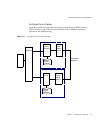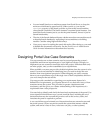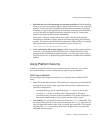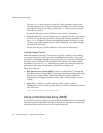Working with Portal Server Building Modules
98 Portal Server 6 2005Q1 • Deployment Planning Guide
• If you use multiple machines, or if your Portal Server machine is running a
large number of instances, use a fast network interconnect.
• On servers with more than eight CPUs, create processor sets or domains with
either two or four CPUs. For example, if you choose to install two instances of
Portal Server on an eight CPU server, create two four-CPU processor sets.
Directory Server Requirements
Identify your Directory Server requirements for your building module
deployment. For specific information on Directory Server deployment, see the
Directory Server Deployment Guide.
Consider the following Directory Server guidelines when you plan your Portal
Server deployment:
• The amount of needed CPU in the Directory Server consumer replica processor
set depends on the number of Portal Server instances in the building module as
well as performance and capacity considerations.
• If possible, dedicate a Directory Server instance for the sole use of the Portal
Server instances in a building module. (See Figure 5-2 on page 89.)
• Map the entire directory database indexes and cache in memory to avoid disk
latency issues.
• When deploying multiple building modules, use a multi-master configuration
to work around bottlenecks caused by the profile updates and replication
overhead to the Directory Server supplier.
Search Engine Structure
When you deploy the Search Engine as part of your building module solution,
consider the following:
• In each building module, make sure only one Portal Server instance has the
Search Engine database containing the RDs. The remaining Portal Server
instances have default empty Search Engine databases.
• Factors that influence whether to use a building module for the portal Search
database include the intensity of search activities in a Portal Server
deployment, the range of search hits, and the average number of search hits for
all users, in addition to the number of concurrent searches. For example, the
load generated on a server by the Search Engine can be both memory and CPU
intensive for a large index and heavy query load.


















